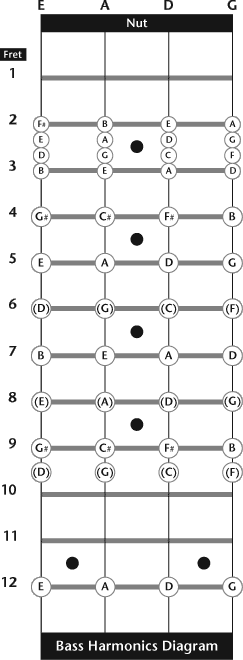| Online Bass Instruction with Rusty Springfield | ||
 |
||
|
Home | eMail | Articles | Audio Clips | Bass Gallery
Great Bass Tales | Photo Archive | Links | Lessons |
||
| Harmonics |
|
||
The principle behind harmonics is fairly simple. Think of how a prism separates white light into many colors. The colors were already present in the white light, but the prism acts as a filter and separates the colors so that we can observe them one by one. By touching a string at certain points along it's length in the manner I've just described, you are essentially doing the same thing, sonically.
These node points occur at mathematical intervals which divide the string into fractions. The first harmonic point occurs at the string's halfway point, just above the twelfth fret. (You must play the harmonic right over the fret.) This produces a tone which is one octave above the open string. If you follow the same procedure over the fifth fret, you will produce a tone that is two octaves above the open string. Playing the harmonic over the seventh fret produces the interval of a fifth. As I mentioned earlier, it is common practice to tune a bass (or guitar) by playing the seventh fret harmonic on one string and then immediately playing the fifth fret harmonic on the adjacent lower (in pitch) string. On an instrument tuned in fourths, like a bass guitar, these two harmonic points produce the same note, allowing the player to tune each successive string until the two harmonics are in perfect unison.
Actually, there are many node points along each string, and you should feel free to explore them for their musical possibilities. I have included a chart to help you get started. It lists the harmonics by note name, in easy-to-see tablature form. Be aware that the harmonics below the twelfth fret also appear in mirror image above the twelfth fret.
Since the twelfth fret is the exact halfway point between the nut and the bridge, the same harmonics appear on either side of it. It is generally easier to play the ones I have diagrammed here.
| Go to the next lesson: False Harmonics |
